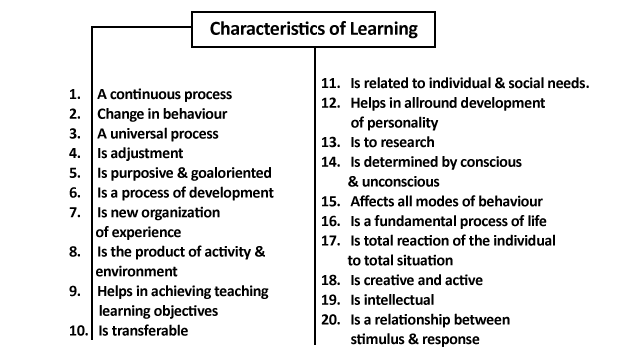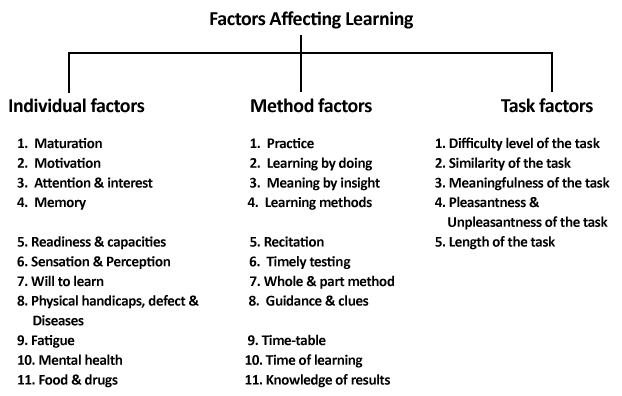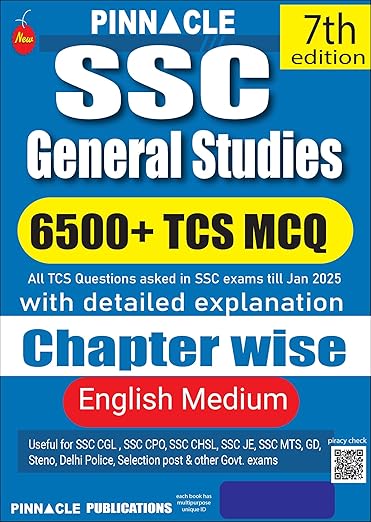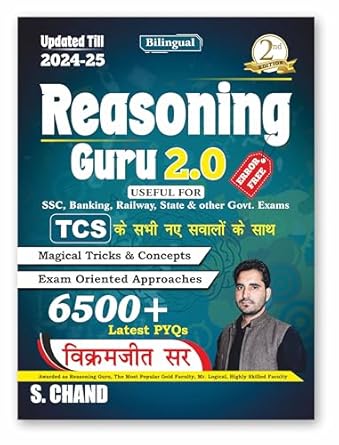- Motivation
- Theories of Learning
- Learning and Motivation
- Types of Learning
- Factors for Motivation
- Right of Children
- Right to Education
- Benefits of Right
Learning and Motivation Syllabus and Study Material
Concept of Learning
In the process of education learning occupies a quite central place. That ever exists in our educational set up is meant for the learning of the learners i.e. students. So “fore it is quite essential for you as a would be teacher to be acquainted with the concept of the term learning. Let us analyse the concept of the term learning by
- Knowing about its meaning and definitions and
- Knowing about the process of learning.
- Gardner Murphy – “The term learning covers every modification in behaviour to meet environmental requirements.”
- Henry P. Smith – “Learning is the acquisition of new behavior or the strengthening or weakening of old behavior as the result of experience.
- Woodworth – “Any activity can be called learning so far as it develops the individual (in any respect, good or bad) and makes him alter behavior and experiences different from what that would otherwise have been.
- Kingsley and Garry – “Learning is the process by which behavior (in the broader sense) is organized or changes through practice or training”.
Motivation
- “Motivation is the basic problem of psychology in Education.” – Bernard
- “Motivation is the super-highway to learning.” – Skinner
- “Motivation is the central factor in the efficient management of the process of learning. Some type of motivation must be present in all learning.” – Kelly

The Motivational Cycle

Theories of Learning
Learning the theories have generated controversy which has extended research in several directions, with the result that some psychologists are beginning to think in terms of learning “systems” rather than of one theoretical approach that covers everything. But even this statement can raise controversy.
- Association Theory. Around 1900,E.L.. Thorn dike (55) proposed that the basic process Involved in learning was one of “stamp- Ing out” incorrect resportises. In this way, “bonds” are established between stimulus impressions and response tendencies. We can think of these as “S-F?” connections. This principle of reward is a central concept in association theory, which may also include “S-S” (Stimulus-Stimulus) associations, particularly In perceptual learning, Hero ‘ho learner comes to know more about the stimulus situation. Because two stimulation repeatedly associated, one stimulus will arouse an image or some process representing the second stimulus. Expanding this concept, we can see how. Many associates are brought into being, since almost any stimulus situation contains many stimuli, not just two. Even the context of the classroom situation is important.
- Drive Stimulus Reduction Theory. Postulated by C.L. Hull (26) in the 1910s, drive stimulus reduction theory assumes four things. First, that which is learned is a connection between a stimulus and a response, a unit of learning called “habit strength” Second, reinforcement is a necessary condition for learning. Hull assumed that reinforces gain their effectiveness by reducing the level of the existing drive. Hence the name, drive reduction theory. Third, the learned connection between a stimulus and a response is assumed gradually of increase in magnitude to bring about a relatively permanent change in behavior. Fourth, there are factors which influence whether a habit will be performed and other factors which detract from the tendency to perform. Influencing factors include the level of the drive and the magnitude of the rein-lorcer. Detraction factors include the amount ( effort and fatigue involved in responding.
- Cognitive Theories. Learning to solve problems, to reason, and to grasp a new language extend learning theory to include the higher mental processes. Here “cognition's” are intervening variables put together out of perceptions of one’s own environment, which also involves beliefs or knowledge about the person’s environment. One can thus think of learning as a matter of acquiring information rather than just building up specific S-R associations. Cognitive theories are interested in voluntary behavior. As learning situations become more complex, there is a likelihood that instead of being elicited automatically, responses will be influenced by implicated processes, or “cognitive maps.” Where the stimulus response theories says that what are learned are cognitive structure. In other words, we get a “mental picture” of what is going on. We form a cognitive map of going downtown or solving an academic problem in terms of our personal experiences. Let us contrast S.R. theory and cognitive theory in terms of a rat learning a mze. For the S.R. theory, the rat learns a sequence of responses –left, right, left, right, right – to get to the food. Hence, we have behavior movements that are learned. For the cognitive theorist, the rat learns where the food is and how to get there, not the particular motor sequence of responses involved.
| Classical Respondent Conditioning | Operant Conditioning |
| It helps in the learning of respondent behaviour. | It helps in the learning of operant behaviour. |
| It is called type S conditioning to emphasize the importance of the stimulus in eliciting desired response. | It is called type R conditioning because of the emphasis on the response. |
| In this type of conditioning beginning is being they | Here beginning is made with the responses as they occur "naturally" or "unnaturally" shaping the |
| Made with the help of specific ‘stimuli that bring certain responses. Here strength of conditioning is usually determined by the magnitude of the conditioned response i.e., the amount of saliva (as in the case of classical experiment of Pavlov with dog). | Here strength of conditioning is shown by the response i.e., the rate with which an operant response occurs as a result of some reinforcement. |

Learning and Motivation
Taylor defines motivation as a process, or a series of processes, which somelra wstajts, steers, sustains and finally stops a goal directed sequence of behavior. Motivation is highly relevant to the following:
- Direction of behavior: the goal or goals being pursued.
- Intensity of behavior: the amount of effort, concentration, and so on, invested in behavior.
- Persistence of behavior: the extent to which a goal, is pursued until it is reached.
Motives originate during our lifetime, largely through experiences involving other people, because, they are developed through personal and social contracts, these motives are referred to as personal, social or acquired motives. Some of our motives are inborn, determined by our physiological inheritance. Learning: depends to a large extent on motivation. No matter what is learnt, the speed and efficiency would depend on motivation. Motivation is concerned with the arousal of interest in learning and is basic in learning. Motivation is effective only when it gives a mental set toward learning. Continuous motivation is needed, in order to help learners concentrate on the learning material. Motivation through rewards has certain definite advantages- It is a positive approach. It also utilities the human desire for approval. Motivational factors are “activating” variables, whereas learning factors are “associative” ones. Various learning theories view this differently. Stimulus-Response (S-R) theories treat man as a machine. For them, the organism is governed by fixed principles and motivation of behavior originates from psychological drives. On the basis of cause-effect, the behavior of organisms can be predicted. Motivation is an urge to act. This urge results from stimuli which may be internal or external. Behavior does not consider any ‘purpose.’ S-R theories give importance to past experiences to explain the causes of present behavior. Motivation results from psychological situations, which are created by disequilibrium in individual’s life span. Cognitive field theories emphasis present experiences. Their approach is a situational approach to motivation and behavior. Their emphasis is on the effects of field conditions and other variables. Motivation itself could be said to be learned. Educational psychologists have always had a special interest in the relationship between learning and motivation. According to educational psychologists, three factors affect learning;
- Motivational factors
- Physiological factors
- Environment factors.
Motivational factors are psychological factors that condition learning. Sufficient motivational force, not only initiates activity which results in learning, but also sustains and directs its. Kinds of Motivation: There are two kinds of motivation in the context of learning. These are:
- Intrinsic motivation; and
- Extrinsic motivation. Intrinsic motivation is the most effective type of drive which makes the matter to be learnt significant or meaningful to the learner. Extrinsic motivation which is external to the learning activity includes praise and blame, rivalry, rewards, punishments, and knowledge of progress (KOP). Other sources of motivation may include desire for social approval, urge to dominate, urge to excel and so on. Individuals differ greatly in their achievements and power motivations.
| Needs of the learners | Learning structures | Learning objectives | Techniques of Motivation |
| Lower Needs | (Extrinsic) | ||
| Physiological needs | Signal learning | Knowledge | Reward and punishment (at Primary level of education) |
| Need of safety | Chain learning | Comprehension | Praise and reproof (at Secondary level of education) |
| Need of Belongingness | Multiple-discrimination | Comprehension | Success of failure (at Secondary level of education) |
| Higher Needs | |||
| Esteem needs | Concept learning | Application | Competition and cooperation (At higher level of education) |
| Need of self Actualization | Principle learning | Creativity or Analysis, synthesis Analysis, synthesis | Knowledge of the result |
| Novelty | |||
| (Intrinsic) | |||
| Level of aspiration | |||
| Self-motivation |
Factors Accounting for Motivation
There are four factors which account for motivation –
- Arousal
- Expectancy
- Incentives
- Punishment
Theories of Motivation
The main theories of Motivation are as under –
- Instinctive Theory of Motivation
- Psycho-analytic Theory of Motivation.
- Behaviouristic Theory of Motivation.
- Murray’s Need Theory of Motivation.
- Maslow’s Hierarchical Theory of Motivation.
- Hygiene Theory of Motivation.
- Pawn Theory
Diagram of the Hierarchy of Needs

Learning and Factors Affecting Learning
Teaching, Instruction and Learning: In order to understand there are meaning of teaching, it is essential to understand the difference the difference between Teaching, Instruction, and learning. Hence, we are clarifying the differences in these three terms in the following line?
- Teaching: In teaching, an interaction occurs between the teacher and the pupils. As a result of which the pupils are diverted towards the objective*. In order words, the main element of teaching i.e. the mutual relationship or the interaction between the teacher and the pupils advances the pupils towards objectives.
- Instruction: The instruction does not involve an interaction between the teacher and the pupil. Still the instruction can divert the pupils towards objectives. The main difference between teaching and instruction is that the teaching includes instruction but the instruction does not include teaching. Hence, the teaching is instruction but the instruction is not teaching. In spite of this, all the three cognitive, affective and psychomotor aspects of the pupils can be developed by teaching, while by instruction, only cognitive aspect can be developed. Hence, no instruction can replace the teaching. In short, instruction is that process which diverts the pupils towards the objectives of cognitive aspect.
- Learning: Learning means – (a) activities and (b) experience. Both teaching and instruction influence learning through various activities and experiences. Hence, the learning and teaching mean the modification of pupils’ behaviour through activities and experiences.



Right of Children to Free and Compulsory Education Act
Provides for free and compulsory education to all children of the age of six to children years
The Right of children to Free and Compulsory Education Act has come into force from today, April 1, 2010. This is a historic day for the people of India as from this day for the people of India as from this day the right to education will be accorded the same legal status as the right to life as provided by Article 21 A of the Indian Constitution. Every child in the age group of 6-14 years will be provided 8 years of elementary education in an age appropriate classroom in the vicinity of his/her neighborhood.
Any cost that prevents a child from accessing school will be borne by the State which shall have the responsibility of enrolling the child as well as ensuring attendance and completion of 8 years of schooling. No child shall be denied admission for want of documents; no child shall be turned away if the admission cycle in the school is over and no child shall be asked to take an admission test. Children with disabilities will also be educated in the mainstream schools. The Prime Minister Shri Manmohan Singh has emphasized that it is important for the country that if we nurture our children and young people with the right education, India’s future as a strong and prosperous country is secure.
All private schools shall be required to enroll children from weaker sections and disadvantaged communities in their incoming class to the extent of 25% of their enrolment, by simple random selection. No seats in this quota can be left vacant. These children will be treated on par with all the other children in the school and subsidized by State at the rate of average per learner costs in the government schools (unless the per learner costs in the private school are lower).
All schools will have to prescribe to norms and standards laid out in the Act and no school that does not fulfill these standards within 3 years will be allowed to function. All private schools will have to apply for recognition, failings which they will be continue to function will be liable to pay Rs 10,000 per day as fine. Norms and standards of teacher qualification and training are also being laid down by an Academic Authority. Teachers in all schools will have to subscribe to these norms within 5 years.
Right to Education Act, 2009 Rules
The National Commission for Protection of Child Rights (NCPCR) has been mandated to monitor the implementation of this historic Right. A special Division within NCPCR will undertake this huge and important task in the coming months and years. A special toll free helping to register complaints will be set up by NCPCR for this purpose. NCPCR welcomes the formal notification of this Act and looks forward to playing an active role in ensuring its successful implementation.
NCPCR also invites all civil society groups, students, teachers, administrators, artist, writers, government personnel, legislators, members of the judiciary and all other stakeholders to join hands and work together to build a movement to ensure that every child of this country is in school and enabled to get at least 8 years of qualities education.
Benefits of Right to Education Act, 2009
RTE has been a part of the directive principles of the State Policy under Article 45 of the Constitution, which is part of Chapter 4 of the Constitution. And rights in Chapter 4 are not enforceable. For the first time in the history of India we have made this right enforceable by putting it in Chapter 3 of the Constitution as Article 21. This entitles children to have the right to education enforced a fundamental right.




This is really really nice... well said and clearly explained... good job🙌